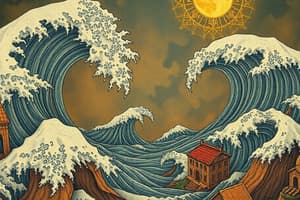Podcast
Questions and Answers
Which factor is NOT directly used by seismologists to assess earthquake risk?
Which factor is NOT directly used by seismologists to assess earthquake risk?
- Geological composition around fault lines
- Population density in the region
- Proximity to active volcanic areas (correct)
- Historical record of past earthquakes
The Modified Mercalli scale measures which characteristic of an earthquake?
The Modified Mercalli scale measures which characteristic of an earthquake?
- Intensity based on observed damage (correct)
- Total energy released
- Probability of future quakes
- Ground deformation
Which type of volcano is characterized by its large size, gentle slopes, and relatively gentle eruptions?
Which type of volcano is characterized by its large size, gentle slopes, and relatively gentle eruptions?
- Cinder cone volcano
- Shield volcano (correct)
- Stratovolcano
- Composite volcano
What geological setting is LEAST likely to generate volcanoes?
What geological setting is LEAST likely to generate volcanoes?
Which of the following eruption characteristics is most closely associated with violent volcanic eruptions?
Which of the following eruption characteristics is most closely associated with violent volcanic eruptions?
What is a caldera formed from?
What is a caldera formed from?
Which volcanic hazard is LEAST likely to cause fatalities?
Which volcanic hazard is LEAST likely to cause fatalities?
What observation would suggest that a volcanic eruption is becoming more likely?
What observation would suggest that a volcanic eruption is becoming more likely?
Which type of seismic wave CANNOT travel through Earth's liquid outer core, providing evidence of its state?
Which type of seismic wave CANNOT travel through Earth's liquid outer core, providing evidence of its state?
At what plate boundary is a reverse fault MOST likely to occur?
At what plate boundary is a reverse fault MOST likely to occur?
What data is required to determine the epicenter of an earthquake using triangulation?
What data is required to determine the epicenter of an earthquake using triangulation?
Which of the following statements accurately describes the relationship between the focus and epicenter of an earthquake?
Which of the following statements accurately describes the relationship between the focus and epicenter of an earthquake?
If a seismograph station records a significant difference in arrival times between the P-wave and S-wave, what can be inferred about the station's location?
If a seismograph station records a significant difference in arrival times between the P-wave and S-wave, what can be inferred about the station's location?
A seismograph station is $500 ext{ km}$ away from the epicenter of an earthquake. The P-wave arrives at $10:00:00$ AM. If the S-wave typically travels at approximately $60%$ of the speed of the P-wave, approximately when will the S-wave arrive?
A seismograph station is $500 ext{ km}$ away from the epicenter of an earthquake. The P-wave arrives at $10:00:00$ AM. If the S-wave typically travels at approximately $60%$ of the speed of the P-wave, approximately when will the S-wave arrive?
Which of the following statements best describes the Richter scale?
Which of the following statements best describes the Richter scale?
A homeowner feels a sudden shaking and notices items falling off shelves followed soon after by rolling motions. What sequence of seismic waves likely caused these observations?
A homeowner feels a sudden shaking and notices items falling off shelves followed soon after by rolling motions. What sequence of seismic waves likely caused these observations?
Flashcards
Moment Magnitude Scale
Moment Magnitude Scale
Measures the total energy released by an earthquake.
Modified Mercalli Scale
Modified Mercalli Scale
Measures the intensity of an earthquake based on damage (I-XII).
Volcano
Volcano
A vent in Earth's crust through which molten rock flows.
Volcano formation at convergent boundaries.
Volcano formation at convergent boundaries.
Signup and view all the flashcards
Shield Volcano
Shield Volcano
Signup and view all the flashcards
Composite Volcano
Composite Volcano
Signup and view all the flashcards
Cinder Cone Volcano
Cinder Cone Volcano
Signup and view all the flashcards
Caldera
Caldera
Signup and view all the flashcards
Earthquake
Earthquake
Signup and view all the flashcards
Fault
Fault
Signup and view all the flashcards
Strike-Slip Fault
Strike-Slip Fault
Signup and view all the flashcards
Normal Fault
Normal Fault
Signup and view all the flashcards
Reverse Fault
Reverse Fault
Signup and view all the flashcards
Seismic Waves
Seismic Waves
Signup and view all the flashcards
Focus
Focus
Signup and view all the flashcards
Epicenter
Epicenter
Signup and view all the flashcards
Study Notes
Earthquakes
- Vibrations in the earth's ground are due to the movement of plate at fault lines and are called earthquakes
- Most earthquakes occur along plate boundaries
Faults
- Faults: A break in earth's lithosphere where one block of rock moves towards, away from or past another block of rock
- Strike slip faults occur at transform plate boundaries
- Normal faults occur at a divergent plate boundaries
- Reverse faults occur at convergent late boundaries
Earthquakes Components
- Seismic Waves: Energy that travels as vibrations
- Focus: A point inside the earth where the earthquakes first start
- Epicenter: The location on earth's surface directly above the focus
Types of Seismic Waves
- Primary Waves: Travels in push pull motion, fastest moving seismic waves, and can travel through solids and liquids.
- Secondary waves: Moves in a rolling motion, slowest seismic wave, causes the most damage to Earth's surface
- Surface waves: Moves in a rolling motion, slowest seismic wave, courses most damage to earth's surface
Earths Interior
- S-waves cannot travel through liquids, but p-waves can travel through both solid and liquids leading scientist to discover that the outer core is liquid
Finding an Epicenter Through Triangulation
- Find the difference between the arrival time of the p-wave and the arrival time of the s-wave
- Determine the distance of the epicenter using a earthquake distance graph
- A circle with the correct distance around the station must be drawn and repeated for two more stations
- Where the circles intersect, is the epicenter
Scales to Measure Earthquakes
- Richter scale: Measures the amount of ground motion at a given distance
- Moment magnitude: Measures the total amount of energy release by an earthquake
- Modified Mercalli scale: Measures the intensity of an earthquake Based on amount of damage and has levels 1 - XII
Earthquake Risks
- Seismologist use 5 indicators to assess earthquake risk
- Namely past earthquakes, probability, population density, geology around a fault, & building design
Volcano
- Volcano: A vent earth crust trough which molten rck flows
Volcano Formation
- Convergent boundaries: Two plates collide and one plate subduct under another plate causing volcanoes to form
- Divergent boundaries: Two plates separate and magma comes out for example mid-ocean ridges and rift valleys
- Hot spots: Volcanoes that are not associated with plate boundaries such as Hawaii
Types of Volcanoes
- Shield volcano: Large shield shaped Volcanoes with gentle slopes and gentle eruptions
- Composite volcano: Large steep-sided Volcanoes, that result from explosive eruptions
- Cinder cone volcano: small, steep-sided volcanoes that erupt gas rich, basaltic lavas. Moderately explosive eruptions
Caldera
- Caldera: Large volcanic depression create when the summit of the volcano collapsed during a violent eruption
Types of Eruptions
- Violent Eruptions: Lava has high viscosity thick lava and high gas content
- Quiet Eruptions: Lava has low viscosity thin lava and low gas content
Effects of Volcanic Eruptions
- Lava flow: Moves slowly, can destroy towns, and are rarely deadly
- Ash fall: Cases breathing problems, can cool earth's atmosphere and can disrupt Air traffic
- Mudflow: Causes snow and ice to melt, which mixes with mud ash
- Pyroclastic Flows: Can be deadly, produced from violent eruptions, and throw gas, ash and Rock into the air
Predicting Volcanoes
- Through Ground deformation observed, increase in earthquakes, volcanic gas increases and water near the volcano that becomes more acidic
Climate
- Volcanic eruptions blocks the sun and causes a decrease in global temperatures & also causes acid rain
Studying That Suits You
Use AI to generate personalized quizzes and flashcards to suit your learning preferences.




